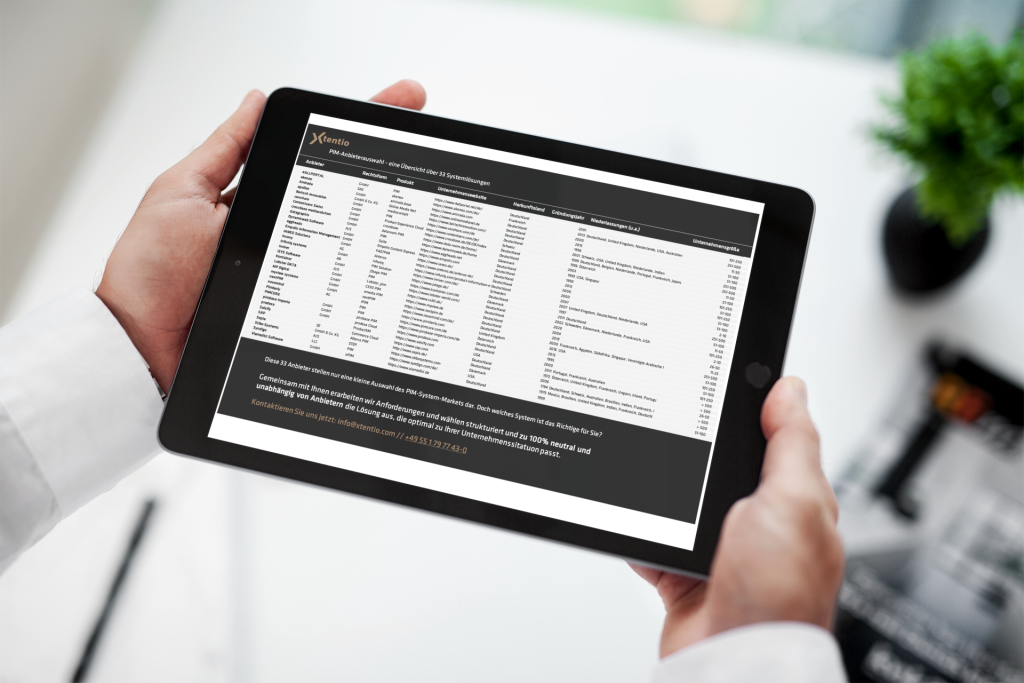
PIM is short for Product Information Management and offers companies significant benefits, such as higher e-commerce conversion rates, consistent product data, and efficient data delivery to digital touchpoints. PIM systems are specialized software solutions that consolidate, enrich, and deliver product information via one central platform.
PIM accelerates time-to-market for product launches, reduces inaccurate product information and thus minimizes process errors (e.g. returns). It offers high potential regarding the automation of providing data to various sales channels (e.g., online stores, online marketplaces, catalog creation).
PIM is short for Product Information Management and is an enterprise-wide discipline.
PIM systems help companies capture, manage and deliver product information.
Benefits of Product Information Management
With Product Information Management, companies are able to provide detailed product information – based on target audiences and communication channels – and therefore can address customers individually . This allows targeting customers with relevant product information, which results in higher conversion rates and increased sales.
Inkonsistenzen in Produktinformationen sorgen immer wieder für hohe Abbruchraten in den Customer Journeys vieler Unternehmen. Durch die Vielzahl an Touchpoints (z. B. E-Mail-Newsletter, Social-Media-Post, Online-Shops) kommt ein Kunde mehrfach mit den Produktinformationen in Berührung, bevor eine Kaufentscheidung gefällt wird. Mit PIM verhindern Unternehmen Medienbrüche und verschiedene Datenstände entlang der Customer Journey, sodass Kunden eine nahtlose Customer Experience genießen.
With PIM, companies ensure the dimensions of data quality (consistency, correctness, timeliness, completeness, relevance, comprehensibility). A PIM system transmits product information to connected customer touchpoint systems (e.g., email marketing systems, social media management systems, content management systems) and thus ensures consistent product presentation throughout the customer journey. This gives the customer a real and complete impression of the product even before the purchase. Cost and effort drivers such as order errors, service calls, and returns can be significantly reduced.
Historisch liegen Produktdaten oftmals verteilt in verschiedenen Systemen (z. B. ERP-System, CMS-System, InDesign-Dateien von Print-Werbemitteln), wodurch unterschiedliche Datenstände verursacht werden. Hinzu kommt, dass Stakeholder immense Suchkosten aufwenden müssen, um an die benötigten Produktinformationen zu gelangen.
With a PIM system, product information is centralized for the first time and made available to relevant stakeholders. This “single point of truth” creates a complete and up-to-date digital image of the physical product. Thanks to PIM marketing, sales, and customer service can access the up-to-date data set for their individual use cases without having to spend time searching.
New product launches are often associated with time-consuming product introductions that can keep the development, marketing, and sales teams occupied for several months. In countless, uncoordinated coordination rounds, e-mails and print documents, databases are exchanged, advertising materials for each channel are created and corrected in feedback loops, until the new product can finally be presented at trade fairs or in the online shop.
PIM as an enterprise discipline finally ensures an end-to-end product data management workflow. The process includes creating the product in development, preparing the promotion in marketing, localizing and translating the product information for other countries, and making it available to sales and service channels. Such a PIM workflow ensures well-defined processes, roles and responsibilities across the organization, accelerating product launches and internationalization.
Multi-level sales and the emergence of online marketplaces make the preparation and delivery of product information mandatory step. Until now, retailers, online stores and marketplaces have often been supplied with product data manually. Entire teams spend time and effort preparing, transforming, and delivering product information to various stakeholders. Often Excel is the tool used for this process.
PIM systems allow to individually manage output structures according to each target channel (e.g. retailer, marketplace). PIM enables the direct maintainance of the required assortments, product data, and data transformations. This gives companies full visibility into externally provided product data and the ability to connect to new channels, retailers, and marketplaces much faster.
PIM vendor selection
There are numerous PIM systems on the market with a wide variety of features and applications. Which system meets your needs?
Take a look at 33 of the most popular tools with our vendor selection.

What our clients say about us



Lisa Limbach
Head of Sales
Register now and get a free expert consultation
Frequently Asked Questions
PIM stands for Product Information Management and refers to a system that enables companies to optimize and seamlessly manage product information. Through a PIM system, companies can ensure that product information is presented consistently, accurately and uniformly across different sales channels.
By providing an end-to-end workflow for product information, the PIM system enables teams to accelerate new product launches and make processes such as connecting new sales channels or internationalizing products faster and more cost-effective.
A PIM system enables companies to manage individual output structures for each target channel (e.g. retailers, online marketplaces). This allows teams to save time and effort and provide product information directly to these channels.
The market offers a wide range of potential PIM solutions for your company. When selecting a PIM system, your individual requirements must be analyzed in detail to find the PIM system that really fits your company.
With years of experience and 100% independence from software vendors and integrators, our team is happy to assist you in choosing the optimal PIM software solution for your business.
Get advice now

